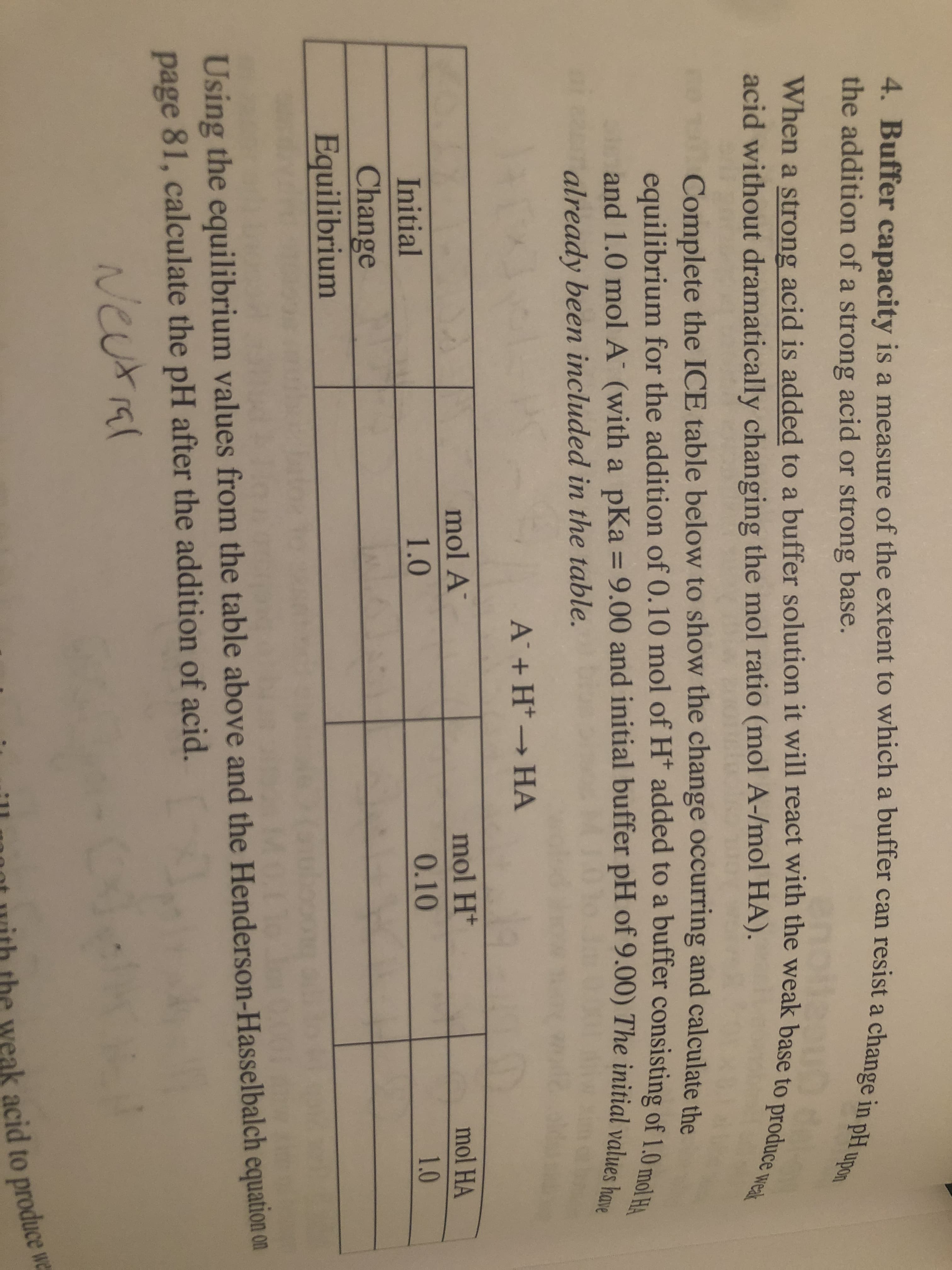4. Buffer capacity is a measure of the extent to which a buffer can resist a change in pH upon the addition of a strong acid or strong base. When a strong acid is added to a buffer solution it will react with the weak base to produce wea acid without dramatically changing the mol ratio (mol A-/mol HA). Complete the ICE table below to show the change occurring and calculate the equilibrium for the addition of 0.10 mol of H* added to a buffer consisting of 1.0 mol HA and 1.0 mol A (with a pKa = 9.00 and initial buffer pH of 9.00) The initial values have %3D already been included in the table. A +H* HA mol A mol H* mol HA Initial 1.0 0.10 1.0 Change Equilibrium Using the equilibrium values from the table above and the Henderson-Hasselbalch equation on page 81, calculate the pH after the addition of acid. Neutial s acid to produce we
4. Buffer capacity is a measure of the extent to which a buffer can resist a change in pH upon the addition of a strong acid or strong base. When a strong acid is added to a buffer solution it will react with the weak base to produce wea acid without dramatically changing the mol ratio (mol A-/mol HA). Complete the ICE table below to show the change occurring and calculate the equilibrium for the addition of 0.10 mol of H* added to a buffer consisting of 1.0 mol HA and 1.0 mol A (with a pKa = 9.00 and initial buffer pH of 9.00) The initial values have %3D already been included in the table. A +H* HA mol A mol H* mol HA Initial 1.0 0.10 1.0 Change Equilibrium Using the equilibrium values from the table above and the Henderson-Hasselbalch equation on page 81, calculate the pH after the addition of acid. Neutial s acid to produce we
Chapter15: Acid-base Equilibria
Section: Chapter Questions
Problem 2RQ: Define a buffer solution. What makes up a buffer solution? How do buffers absorb added H+ or OH with...
Related questions
Question
Complete the ICE table below to show the change occurring and calculate the equilibrium for the addition of 0.10 mol of H+ added to a buffer consisting of 1.0 mol HA and 1.0 mol A- (with a pKa=9.00)

Transcribed Image Text:4. Buffer capacity is a measure of the extent to which a buffer can resist a change in pH upon
the addition of a strong acid or strong base.
When a strong acid is added to a buffer solution it will react with the weak base to produce wea
acid without dramatically changing the mol ratio (mol A-/mol HA).
Complete the ICE table below to show the change occurring and calculate the
equilibrium for the addition of 0.10 mol of H* added to a buffer consisting of 1.0 mol HA
and 1.0 mol A (with a pKa = 9.00 and initial buffer pH of 9.00) The initial values have
%3D
already been included in the table.
A +H* HA
mol A
mol H*
mol HA
Initial
1.0
0.10
1.0
Change
Equilibrium
Using the equilibrium values from the table above and the Henderson-Hasselbalch equation on
page 81, calculate the pH after the addition of acid.
Neutial
s acid to produce we
Expert Solution
This question has been solved!
Explore an expertly crafted, step-by-step solution for a thorough understanding of key concepts.
This is a popular solution!
Trending now
This is a popular solution!
Step by step
Solved in 3 steps with 3 images

Knowledge Booster
Learn more about
Need a deep-dive on the concept behind this application? Look no further. Learn more about this topic, chemistry and related others by exploring similar questions and additional content below.Recommended textbooks for you


Chemistry
Chemistry
ISBN:
9781305957404
Author:
Steven S. Zumdahl, Susan A. Zumdahl, Donald J. DeCoste
Publisher:
Cengage Learning

Chemistry: An Atoms First Approach
Chemistry
ISBN:
9781305079243
Author:
Steven S. Zumdahl, Susan A. Zumdahl
Publisher:
Cengage Learning


Chemistry
Chemistry
ISBN:
9781305957404
Author:
Steven S. Zumdahl, Susan A. Zumdahl, Donald J. DeCoste
Publisher:
Cengage Learning

Chemistry: An Atoms First Approach
Chemistry
ISBN:
9781305079243
Author:
Steven S. Zumdahl, Susan A. Zumdahl
Publisher:
Cengage Learning

Chemistry: Principles and Reactions
Chemistry
ISBN:
9781305079373
Author:
William L. Masterton, Cecile N. Hurley
Publisher:
Cengage Learning

Chemistry: Principles and Practice
Chemistry
ISBN:
9780534420123
Author:
Daniel L. Reger, Scott R. Goode, David W. Ball, Edward Mercer
Publisher:
Cengage Learning

Principles of Modern Chemistry
Chemistry
ISBN:
9781305079113
Author:
David W. Oxtoby, H. Pat Gillis, Laurie J. Butler
Publisher:
Cengage Learning